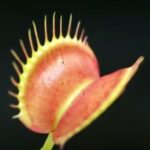As an Amazon Associate, this site earns commissions from qualifying purchases. For more details, click here.
Butterworts are most commonly found throughout Mexico, hence the name Mexican butterworts. They are beautiful plants, bloom twice a year, eat bugs and need little maintenance. Even if you are new to planting, raising butterworts (also known as pinguicula or ping) is simple.
Butterworts are easy to grow when given 6-8 hours of light and can eat every two weeks. Use 50/50 peat moss and perlite for the soil and keep it moist. If humidity is high, reduce watering during winter.
Soil and Water For Pinguicula
The best soil for pinguicula is 1:1 peat moss and perlite. With this mixture you can water the plant as often as necessary to keep the soil moist. Do not let the soil dry out especially during summer.
A 50/50 mix of long fiber sphagnum (LFS} and silica sand can also work. Just like with peat moss and perlite, water the plant when the soil starts to dry.
You can also use 100% pure long fiber sphagnum. There is no mixing required but you have to consider the following. Want to keep things simple? Use Spring and Stone Carnivorous Soil as it is very easy to use.
First, LFS might be too wet for some pinguicula species. Second, the acidity level might be too high. Most butterworts grow in high acid soil, but LFS is too much for some variants. Pure LFS must also be allowed to dry every 30 days. This is not necessary with peat moss and perlite or LFS mixed with silica sand.
You can also combine perlite, pumice, bark and long sphagnum moss. Mix the first three materials thoroughly then add LFS on the top. You can use the tray method with this soil mix and the one with pure LFS, but keep the water level low.
Because pinguicula only grows in poor potting media, they need nutrition from other sources. This does not mean soil is not important. Butterworts still need soil to anchor its roots and keep it stable during heavy rain or strong winds.
Water. Do not use tap water on pinguicula because they are too harsh and can cause severe damage. Use only purified, distilled or reverse osmosis water. If you can collect enough rainwater, that is always a good choice.
There are two ways to water butterworts: from the top and the tray method. Both are fine but need to be done properly to avoid over watering the leaves.
If you are going to water from the top, sprinkle lightly around the rosette, not directly over it. Doing this will prevent water from stagnating on the leaves.
If you are going to water from the bottom via the tray method, use a shallow tray and keep the water level low. This necessary to maintain the right humidity level.
Light and Humidity
Butterworts prefer bright, direct light in the mornings. Their leaves can burn in the midday sun so shade might be needed. You can also grow pinguicula indoors with artificial lights.
Like all carnivorous plants, butterworts require sunlight to produce glucose. Usually 6-8 hours of light is ideal, but it all depends on the intensity. If you live in a sunny, dry location, keep the plant away from the midday sun. Morning sunlight will be fine.
If natural light is limited in your area, use LED like the iPower Dual Grow Light. Position the lights directly or indirectly depending on its intensity. Overall artificial lighting is a good option if going natural is not possible.
Humidity. This is one aspect where butterworts differ from other carnivorous plants. Sundews and Venus flytraps thrive in high humidity up to 80% in some cases. Pinguicula plants however, can grow in lower humidity because that is their natural habitat.
Butterworts grow in low to medium humidity levels, around 20%-50%. Some species do well in higher humidity so it depends on what type of butterwort you have.
As long as a pinguicula receives enough light and is planted in the right soil, low humidity will be sufficient. Never let the plant dry out completely during its growth phase, and humidity will not be an issue. If you notice signs of root rot, humidity is too high.
Nutrition and Feeding
No need to buy special food for butterworts as insects will do just fine. If you have fungus gnats pestering your garden, these plants provide the best solution.
You can give fish food or mealworms to butterworts, and it is ideal if they are too young to catch insects. Hand feeding is also necessary if your pinguicula is in a terrarium. Give it food every two weeks or so and remember to check the humidity to ensure it is appropriate for the plant.
But mature butterworts do not need any help. Leave the plant outdoors or by an open window and bugs will come to it. The key lies in the mucus that the plant secretes all over its leaves. Bugs are attracted to this and will provide more than enough food for your pinguicula.
Pinguicula Propagation
There are three methods for propagating pinguicula: leaf cutting, seeds and division. Leaf cutting produces the fastest results and will be identical to the parent plant.
Leaf Cutting. Also known as leaf pulling, it is the easiest propagation method. The best time to do leaf cutting is early or mid spring when dormancy ends. During this time, pinguicula plants will start growing new leaves.
Hold one of the leaves and pull it down until it comes off the plant. Put this leaf cutting in new potting soil -50/50 peat moss and perlite is a good choice – and wait for the plant to grow. Keep the soil moist and place it under artificial light. As the leaf grows into a new pinguicula, care for it the same way as its mother plant.
Seeds. Get a clear container and make a few holes in it to allow for air to flow.. Place half an inch of LFS moss in the container. Place the seeds on top of the moss, spreading them about an inch apart. Keep the seeds under strong artificial light.
Water the sphagnum moss, just enough to keep it moist. After a few weeks the seeds will grow a little. You can remove the seeds and plant each one in a separate pot.
Division. Divide your pinguicula after several rosettes have appeared and flowering is complete. You know the plant is ready for division when leaves start sprouting on the newly formed rosettes.
Related: How to Propagate Butterworts
Do Butterworts Go Dormant?
Tropical butterworts turn into non-carnivorous succulent plants during dormancy. They will grow carnivorous leaves when spring arrives. Other changes the plant goes through will depend on the species.
Note that some butterworts prefer dry soil during dormancy, but others require them to remain moist. Again this comes down to the variant. Because succulent leaves hold water, you can reduce watering. But if the humidity goes too low it could damage the plant, so a bit of water may help.
Tips for Growing Pinguicula Plants
Pinguicula is not hard to grow. All you need is basic knowledge of what the plant requires. Once the right conditions are met, the plant will need little maintenance.
- Most butterworts need bright sunlight, but avoid exposing them to too much heat.
- There may be some slight variations among species, but generally pinguicula will be fine in low to medium humidity.
- Do not worry about how much food your pinguicula is getting. With enough sunlight the plant needs only little nourishment.
- Signs of a healthy pinguicula are blooming flowers, multiple rosettes and lots of mucus.
- It may take a while for seedlings to grow. And it will not be identical to the original. If you want a clone, use leaf cuttings or division.
Conclusion
One more thing needs to be pointed out. There are many types of pinguicula so their needs will vary. Some species may need more light, others less. Make the proper adjustments so your pinguicula stays healthy and strong.

My fascination with carnivorous plants began many, many years ago with Venus Fly Traps. Now I am more than happy to impart what I know with other enthusiasts and those who are curious about meat eating plants.



